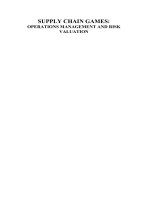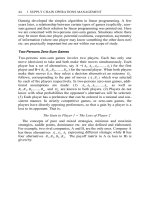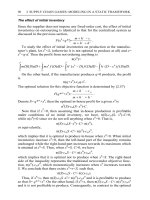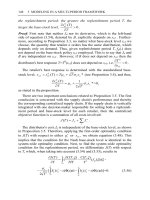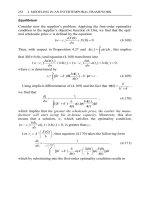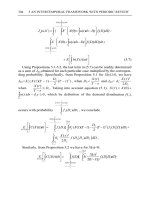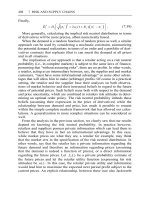Operations management 12th stevenson ch15 supply chain management
Bạn đang xem bản rút gọn của tài liệu. Xem và tải ngay bản đầy đủ của tài liệu tại đây (804.05 KB, 40 trang )
Chapter 15
Supply Chain Management
McGraw-Hill/Irwin
Copyright © 2012 by The McGraw-Hill Companies, Inc. All rights reserved.
Chapter 15: Learning Objectives
You should be able to:
1.
2.
3.
4.
5.
6.
7.
8.
9.
10.
Instructor Slides
Discuss the key issues of supply chain management (SCM)
Name the recent trends in SCM
Summarize the motivations and risks of outsourcing as a strategy
State some of the complexities that are involved with global supply chains
List some of the strategic, tactical and operational responsibilities of SCM
Give examples of some advantages of e-business
Explain the importance of supplier partnerships
Discuss the issues involved in managing returns
List the requirements of an effective supply chain
Name some of the challenges in creating an effective supply chain
15-2
Supply Chain
Supply Chain:
the sequence of organizations - their facilities, functions, and activities - that are
involved in producing and delivering a product or service
Sometimes referred to as value chains
Instructor Slides
15-3
Facilities
The sequence of the supply chain begins with basic suppliers and extends all the
way to the final customer
Warehouses
Factories
Processing centers
Distribution centers
Retail outlets
Offices
Instructor Slides
15-4
Functions and Activities
Supply chain functions and activities
Forecasting
Purchasing
Inventory management
Information management
Quality assurance
Scheduling
Production and delivery
Customer service
Instructor Slides
15-5
Supply Chain Management
Supply Chain Management (SCM)
The strategic coordination of business functions within a business organization
and throughout its supply chain for the purpose of integrating supply and
demand management
Instructor Slides
15-6
SCM Managers
SCM Managers
People at various levels of the organization who are responsible for managing supply and
demand both within and across business organizations.
Involved with planning and coordinating activities
Sourcing and procurement of materials and services
Transformation activities
Logistics
Instructor Slides
15-7
Key SCM Issues
The goal of SCM is to match supply to demand as effectively and efficiently as
possible
Key issues:
Determining appropriate levels of outsourcing
Managing procurement
Managing suppliers
Managing customer relationships
Being able to quickly identify problems and respond to them
Managing risk
Instructor Slides
15-8
Trends in SCM
Trends affecting supply chain design and management:
Measuring supply chain ROI
“Greening” the supply chain
Re-evaluating outsourcing
Integrating IT
Managing risks
Adopting lean principles
Instructor Slides
15-9
Global Supply Chains
Global supply chains
Product design often uses inputs from around the world
Some manufacturing and service activities are outsourced to countries where labor and/or
materials costs are lower
Products are sold globally
Complexities
Language and cultural differences
Currency fluctuations
Political instability
Increasing transportation costs and lead times
Increased need for trust amongst supply chain partners
Instructor Slides
15-10
Management Responsibilities
Aspects of management responsibility:
Legal
Being knowledgeable about laws and regulations of the countries where supply chains
exist
Obeying laws and operating to conform to regulations
Economic
Supplying products and services to meet demand as efficiently as possible
Ethical
Conducing business in ways that are consistent with the moral standards of society
Instructor Slides
15-11
Management Responsibility:
Strategic
Certain strategic responsibilities have a major impact on the success of both
supply chain management and the business itself:
Supply chain strategy alignment
Network configuration
Information technology
Products and services
Capacity planning
Strategic partnerships
Distribution strategy
Uncertainty and risk reduction
Instructor Slides
15-12
Management Responsibility:
Tactical and Operational
Tactical
Operational
Scheduling
Receiving
Transforming
Forecasting
Sourcing
Operations Planning
Order fulfilling
Managing inventory
Managing inventory
Transportation planning
Shipping
Collaborating
Information sharing
Controlling
Instructor Slides
15-13
Procurement
The purchasing department is responsible for obtaining the materials, parts,
and supplies and services needed to produce a product or provide a service.
The goal of procurement
Develop and implement purchasing plans for products and services that support
operations strategies
Instructor Slides
15-14
Duties of purchasing
Identifying sources of supply
Negotiating contracts
Maintaining a database of suppliers
Obtaining goods and services
Managing supplies
Instructor Slides
15-15
The Purchasing Cycle
The main steps:
1.
Purchasing receives the requisition
2.
Purchasing selects a supplier
3.
Purchasing places the order with a vendor
4.
Monitoring orders
5.
Receiving orders
Instructor Slides
15-16
E-Business
E-business
The use of electronic technology to facilitate business transactions
Applications include
Internet buying and selling
Order and shipment tracking
Electronic data interchange
Product and service promotion
Provide information about products and services
Instructor Slides
15-17
Advantages of E-Business
Companies can:
Have a global presence
Improve competitiveness and quality of service
Analyze customer interests
Collect detailed information about clients’ preferences
Shorten supply chain response times
Reduce or eliminate the role of ‘traditional’ retailers and/or intermediaries
Realize substantial cost savings
Also allows the:
Creation of virtual companies
Leveling of the playing field for small companies
Instructor Slides
15-18
E-Business Order Fulfillment Problems
Customer expectations
Order quickly Quick delivery
Demand variability creates order fulfillment problems
Sometimes Internet demand exceeds an organization’s ability to fulfill
orders
Inventory
Outsourcing order fulfillment
Loss of control
Build large warehouses
Internal holding costs
Instructor Slides
15-19
Supplier Management
Choosing suppliers
Supplier audits
Supplier certification
Supplier relationship management
Supplier partnerships
CPFR (collaborative planning, forecasting, and replenishment)
Strategic partnering
Instructor Slides
15-20
Vendor Analysis, Supplier Audits,
and Supplier Certification
Vendor analysis
Evaluating the sources of supply in terms of price, quality, reputation, and service
Supplier audit
A means of keeping current on suppliers’ production (or service) capabilities, quality and delivery
problems and resolutions, and performance on other criteria
Supplier certification
Involves a detailed examination of a supplier’s policies and capabilities
The process verifies the supplier meets or exceeds the requirements of a buyer
Instructor Slides
15-21
Supplier Relationship Management
Type of relationship is often governed by the duration of the trading
relationship
Short-term
Oftentimes involves competitive bidding
Minimal interaction
Medium-term
Often involves an ongoing relationship
Long-term
Often involves greater cooperation that evolves into a partnership
Instructor Slides
15-22
Strategic Partnering
Two or more business organizations that have complementary products or
services join so that each may realize a strategic benefit
Example:
When a supplier agrees to hold inventory for a customer in return for a long-term
commitment
The customer’s inventory holding cost is reduced and the supplier is relieved of the costs that
would be needed to continually find new customers
Instructor Slides
15-23
Inventory Management
Inventory issues in SCM
Inventory location
Centralized inventories
Decentralized inventories
Inventory velocity
The speed at which goods move through a supply chain
The bullwhip effect
Inventory oscillations that become increasingly larger looking backward through the
supply chain
Instructor Slides
15-24
The Bullwhip Effect
Variations in demand cause inventory fluctuations to fluctuate and get out
of control
Inventory fluctuation can be magnified by
Periodic ordering
Reactions to shortages
Forecast inaccuracies
Order batching
Sales incentives and promotions
Liberal product return policies
Results in
Higher costs
Lower customer satisfaction
Instructor Slides
15-25

